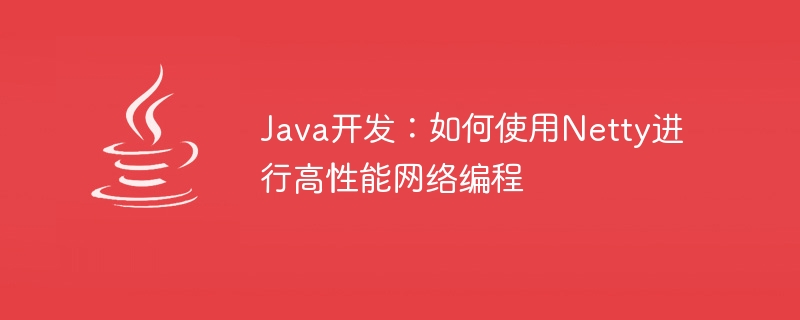Java開發:如何使用Netty進行高效能網路編程

Java開發:如何使用Netty進行高效能網路程式設計
摘要:Netty是一個高效能、非同步事件驅動的網路程式設計框架,能夠簡化網路應用程式的開發過程。本文將介紹Netty的主要特點以及如何使用Netty進行高性能網路程式設計。同時,我們也會提供一些具體的Java程式碼範例,幫助讀者更能理解和應用Netty。
一、Netty簡介
Netty是一個基於Java NIO的網路程式框架,能夠快速、簡單地開發可維護的高效能伺服器和客戶端應用程式。它提供了一套高度抽象的API,使得開發者能夠專注於商業邏輯的實現,而不用過度關注網路IO的底層細節。
Netty的主要特點包括:
- 非同步非阻塞:Netty使用Java NIO提供的非阻塞IO模型,實現了高並發處理和資源節約。
- 事件驅動:Netty基於事件驅動的模型,透過事件分發機制實現了高效率的網路操作。
- 高度可自訂化:Netty提供了一系列的可自訂化選項和處理器,使得開發者能夠根據自己的需求來調整和擴展框架的功能。
- 容錯能力強:Netty的容錯機制能夠處理各種異常情況,確保應用程式的穩定性和可靠性。
- 功能豐富:Netty提供了一系列進階功能,如SSL/TLS支援、HTTP協定的編解碼器、WebSocket等,讓開發者能夠輕鬆建構複雜的網路應用。
二、Netty高效能網路程式設計實踐
下面我們將透過一個簡單的範例來介紹如何使用Netty進行高效能網路程式設計。
- 引入Netty依賴
首先,我們需要在專案的依賴管理中引入Netty的相關依賴。例如在Maven專案中,可以在pom.xml檔案中新增如下配置:
<dependencies>
<dependency>
<groupId>io.netty</groupId>
<artifactId>netty-all</artifactId>
<version>4.1.59.Final</version>
</dependency>
</dependencies>- 編寫服務端程式碼
接下來,我們建立一個簡單的服務端應用程序,用於接收客戶端的連線和訊息。以下是範例程式碼:
public class Server {
public static void main(String[] args) throws Exception {
EventLoopGroup bossGroup = new NioEventLoopGroup();
EventLoopGroup workerGroup = new NioEventLoopGroup();
try {
ServerBootstrap bootstrap = new ServerBootstrap();
bootstrap.group(bossGroup, workerGroup)
.channel(NioServerSocketChannel.class)
.childHandler(new ChannelInitializer<SocketChannel>() {
@Override
public void initChannel(SocketChannel ch) {
ChannelPipeline pipeline = ch.pipeline();
pipeline.addLast(new StringEncoder());
pipeline.addLast(new StringDecoder());
pipeline.addLast(new ServerHandler());
}
});
ChannelFuture future = bootstrap.bind(8888).sync();
future.channel().closeFuture().sync();
} finally {
workerGroup.shutdownGracefully();
bossGroup.shutdownGracefully();
}
}
}在這段程式碼中,我們建立了兩個EventLoopGroup,一個用於處理客戶端的連接,一個用於處理客戶端的請求。然後我們建立了一個ServerBootstrap,設定相關參數,並綁定處理器(ServerHandler)。
- 編寫客戶端程式碼
接下來,我們建立一個簡單的客戶端應用程序,用於向服務端發送訊息並接收服務端的回應。以下是範例程式碼:
public class Client {
public static void main(String[] args) throws Exception {
EventLoopGroup group = new NioEventLoopGroup();
try {
Bootstrap bootstrap = new Bootstrap();
bootstrap.group(group)
.channel(NioSocketChannel.class)
.handler(new ChannelInitializer<SocketChannel>() {
@Override
public void initChannel(SocketChannel ch) {
ChannelPipeline pipeline = ch.pipeline();
pipeline.addLast(new StringEncoder());
pipeline.addLast(new StringDecoder());
pipeline.addLast(new ClientHandler());
}
});
ChannelFuture future = bootstrap.connect("localhost", 8888).sync();
future.channel().closeFuture().sync();
} finally {
group.shutdownGracefully();
}
}
}在這段程式碼中,我們建立了一個EventLoopGroup,然後建立了一個Bootstrap,並設定相關參數並綁定處理器(ClientHandler)。
- 寫處理器程式碼
最後,我們需要寫特定的處理器程式碼,來處理伺服器和用戶端的訊息收發。以下是範例程式碼:
public class ServerHandler extends ChannelInboundHandlerAdapter {
@Override
public void channelRead(ChannelHandlerContext ctx, Object msg) {
System.out.println("Received message from client: " + msg);
ctx.write("Server response: " + msg);
}
@Override
public void channelReadComplete(ChannelHandlerContext ctx) {
ctx.flush();
}
@Override
public void exceptionCaught(ChannelHandlerContext ctx, Throwable cause) {
cause.printStackTrace();
ctx.close();
}
}
public class ClientHandler extends ChannelInboundHandlerAdapter {
@Override
public void channelActive(ChannelHandlerContext ctx) {
ctx.writeAndFlush("Hello from client!");
}
@Override
public void channelRead(ChannelHandlerContext ctx, Object msg) {
System.out.println("Received response from server: " + msg);
}
@Override
public void channelReadComplete(ChannelHandlerContext ctx) {
ctx.flush();
}
@Override
public void exceptionCaught(ChannelHandlerContext ctx, Throwable cause) {
cause.printStackTrace();
ctx.close();
}
}在這段程式碼中,我們分別定義了ServerHandler和ClientHandler,並重寫了對應方法來實作訊息的處理。
三、總結
本文介紹了Netty的主要特點,並以簡單的範例程式碼展示如何使用Netty進行高效能網路程式設計。透過使用Netty,我們可以簡化網路應用程式的開發過程,實現高並發處理和資源節約。希望這篇文章對您理解和應用Netty有所幫助。
參考資料:
- Netty官方文件:https://netty.io/wiki/index.html
- Netty GitHub倉庫:https://github .com/netty/netty
以上是Java開發:如何使用Netty進行高效能網路編程的詳細內容。更多資訊請關注PHP中文網其他相關文章!

熱AI工具

Undresser.AI Undress
人工智慧驅動的應用程序,用於創建逼真的裸體照片

AI Clothes Remover
用於從照片中去除衣服的線上人工智慧工具。

Undress AI Tool
免費脫衣圖片

Clothoff.io
AI脫衣器

AI Hentai Generator
免費產生 AI 無盡。

熱門文章

熱工具

記事本++7.3.1
好用且免費的程式碼編輯器

SublimeText3漢化版
中文版,非常好用

禪工作室 13.0.1
強大的PHP整合開發環境

Dreamweaver CS6
視覺化網頁開發工具

SublimeText3 Mac版
神級程式碼編輯軟體(SublimeText3)

熱門話題
 突破或從Java 8流返回?
Feb 07, 2025 pm 12:09 PM
突破或從Java 8流返回?
Feb 07, 2025 pm 12:09 PM
Java 8引入了Stream API,提供了一種強大且表達力豐富的處理數據集合的方式。然而,使用Stream時,一個常見問題是:如何從forEach操作中中斷或返回? 傳統循環允許提前中斷或返回,但Stream的forEach方法並不直接支持這種方式。本文將解釋原因,並探討在Stream處理系統中實現提前終止的替代方法。 延伸閱讀: Java Stream API改進 理解Stream forEach forEach方法是一個終端操作,它對Stream中的每個元素執行一個操作。它的設計意圖是處
 創造未來:零基礎的 Java 編程
Oct 13, 2024 pm 01:32 PM
創造未來:零基礎的 Java 編程
Oct 13, 2024 pm 01:32 PM
Java是熱門程式語言,適合初學者和經驗豐富的開發者學習。本教學從基礎概念出發,逐步深入解說進階主題。安裝Java開發工具包後,可透過建立簡單的「Hello,World!」程式來實踐程式設計。理解程式碼後,使用命令提示字元編譯並執行程序,控制台上將輸出「Hello,World!」。學習Java開啟了程式設計之旅,隨著掌握程度加深,可創建更複雜的應用程式。












